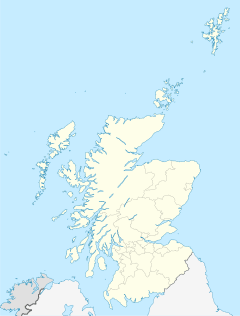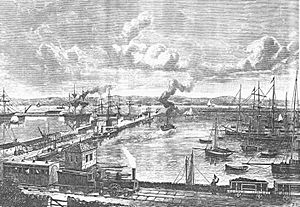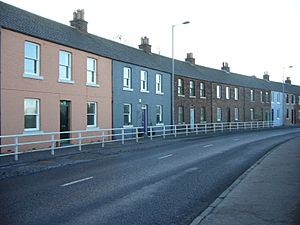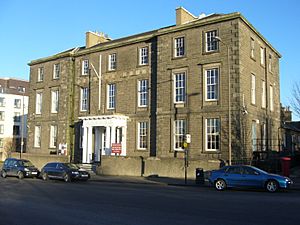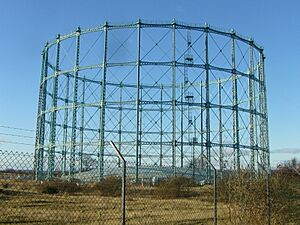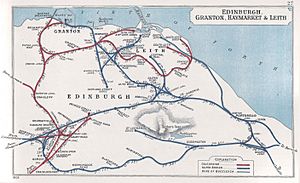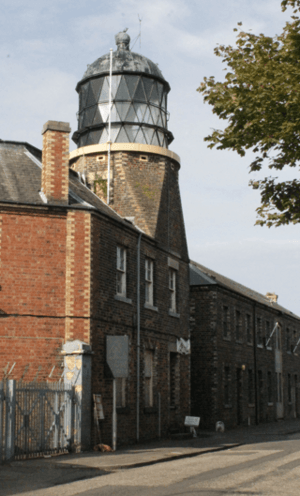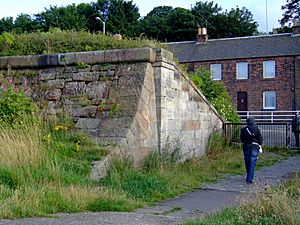Granton, Edinburgh facts for kids
Quick facts for kids Granton |
|
|---|---|
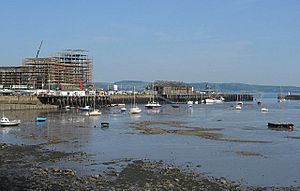 Granton Harbour |
|
| Language | English |
| OS grid reference | NT2377 |
| Civil parish | |
| Council area |
|
| Lieutenancy area | |
| Country | Scotland |
| Sovereign state | United Kingdom |
| Post town | Edinburgh |
| Postcode district | EH5 |
| Dialling code | 0131 |
| Ambulance | Scottish |
| EU Parliament | Scotland |
| UK Parliament | |
| Scottish Parliament | |
Granton is a cool area in the north of Edinburgh, Scotland. It's right on the water, next to the Firth of Forth. Granton has a long history as a busy industrial place with a big harbour. Today, it's part of a huge project to make Edinburgh's waterfront even better!
Contents
What's in a Name?
The name Granton comes from an old Anglian phrase, "grand tun." This meant a farm or a place with gravel or sand. People have been using the name Granton since at least 1478. Later, the area was split into Easter Granton and Wester Granton.
The name Granton also appeared on maps in the 1600s, linked to a place called Granton Castle. There's even a stream called Granton Burn, which flows through Caroline Park to where Granton Beach used to be.
Granton Castle: A Look Back in Time
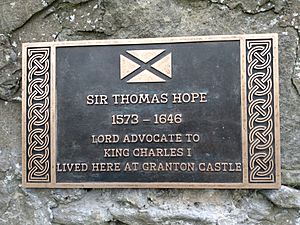
Granton Castle was first mentioned in records in 1479. It was owned by John Melville of Carnbee, Fife. After John passed away, his son, also named John Melville, took over. Sadly, this John Melville was one of many Scottish nobles who died at the Battle of Flodden.
In 1592, the Melville family sold the castle to John Russell. But by 1619, Sir Thomas Hope, who was a very important lawyer called the Lord Advocate, bought it. He made many changes and added to the castle. After he died, his son, Sir John Hope, Lord Craighall, inherited it.
By the 1700s, the castle started to fall apart. In the late 1800s, historians MacGibbon and Ross drew detailed plans of what was left. They showed it was a typical L-shaped Scottish tower house with a courtyard. There was even a "loupin stane" (a set of steps) outside the gate to help people get onto their horses!
In 1928, a company bought the site to dig up the rock under the castle. Most of the castle was destroyed during this work. Luckily, the castle's walled garden still exists today. For many years, it was a small market garden. It was almost lost to new houses, but local people fought to save it. Now, the Friends of Granton Castle Garden look after it as a community space.
Granton Harbour: A Busy Port
In 1834, people in Edinburgh started talking about needing a bigger harbour. A group of engineers and naval officers decided that Granton was the best place for a new one. The plan for Granton was approved in 1837.
Building started in June 1837. The main pier opened on June 28, 1838, just in time for Queen Victoria's coronation! The entire project was paid for by the 5th Duke of Buccleuch. Queen Victoria herself landed at the pier in 1842 during her first official visit to Edinburgh. The pier was made even longer by 1844, reaching about 500 meters (1700 feet).
Later, a famous lighthouse engineer named Robert Stevenson helped build the outer walls of the harbour, which were finished in 1863.
Granton became a very successful port. It exported coal and imported esparto grass, which was used to make paper. The fishing industry also grew a lot. Before World War II, about 80 fishing trawlers called Granton home.
Did you know that the world's first "ferry-train" started operating from Granton on February 3, 1850? A special paddle-steamer called Leviathan carried trains across the Forth to Burntisland, Fife. This was the main way to cross the Forth until the Forth Bridge opened in 1890. Passenger and car ferries continued until the 1960s.
In 1884, a scientist named John Murray opened the first Marine Laboratory in the UK right here in Granton. This lab later moved and became part of what is now the Scottish Association for Marine Science.
During the First World War, Granton harbour was a key base for mine-sweeping ships. These were mainly Scottish trawlers and their crews who joined the Royal Navy Reserve. The harbour was even officially called "HMS Gunner" during this time. It was home to mine-sweepers, decoy ships, and anti-submarine vessels.
Granton Depot was also the main base in Scotland for the Northern Lighthouse Board. Their boats took lighthouse keepers and supplies to lighthouses all around Scotland's coast. Granton also became a base for pilots in 1920, who guide ships safely into the Firth of Forth. This service still operates today.
From 1942 to 1946, Granton harbour was home to a naval training center called HMS Lochinvar. Because the harbour was not big enough for huge ships, it became a place where old Royal Navy ships were taken apart.
Today, two boat clubs, the Forth Corinthian Yacht Club and the Royal Forth Yacht Club, share the Edinburgh Marina in Granton.
Granton's Industries
The Granton quarry (a place where stone is dug out) was first used to get stone for building the harbour. Later, stone from this quarry was used for parts of Holyrood Palace and even for the statue of Lord Nelson on Nelson's Column in Trafalgar Square, London!
The oldest car factory building still standing in Britain is in Granton. The Madelvic Motor Carriage Company built it in 1898 to make electric cars. Like the old gasometers, this factory is a listed building, meaning it's protected. However, there are plans to take it down as part of new developments. In 2017, permission was given to create a community garden on the site. In 2021, a special "Red Wheel" plaque was put up there. These plaques mark important places in transport history.
The Granton Gasworks used to be a very noticeable landmark on Edinburgh's waterfront. There were three huge blue gasometers that you could easily see from Fife. Two of them have been taken down, but the third one remains. It's a protected building because it's a great example of Victorian industrial design. In 2023, the inner part of the remaining gas holder was removed, but the listed frame will stay and be a cool part of the new waterfront area.
During World War Two, factories like Bruce Peebles (later Parsons Peebles) were built in Granton. They made high-voltage electrical equipment. The factory burned down in 1999, and that area is now part of the waterfront redevelopment. Another company, Ferranti, had a factory on Ferry Road that made electronics for aircraft, including special gun sights for the Supermarine Spitfire planes.
Getting Around Granton
Buses
Most bus services in Granton are run by Lothian Buses. Buses that end their journey in Granton usually stop at Granton Square or the Scottish Gas HQ.
Here are some of the bus routes that serve Granton:
- 8: Muirhouse - Granton - Pilton - Canonmills - North Bridge - Newington - Moredun - Royal Infirmary
- 14: Muirhouse - Granton - Pilton - Ferry Road - Elm Row - North Bridge - Newington - Prestonfield - Niddrie
- 16: Colinton - Oxgangs - Morningside - Tollcross - Princes Street - Leith - Newhaven - Granton - Muirhouse - Silverknowes
- 19: Granton - Pilton - Western General - West End - Princes Street - Meadowbank - Lochend - Portobello
- 24: West Granton - Muirhouse - Drylaw - Western General - Stockbridge - West End - The Meadows - Blackford - Royal Infirmary
- 32: Granton - Muirhouse - Davidson Mains - Drum Brae - Sighthill - Wester Hailes
- 38: West Granton - Western General - Craigleith - Ravelston - Murrayfield - Gorgie - Morningside - Blackford - Kings Building - Royal Infirmary
- 47/X37: Granton - Western General - West End - Lothian Road (47) Princes Street (X37) - Newington - Liberton - Straiton - Penicuik Ladywood (47) Penicuik Deanburn (X37)
- N16: Torphin - Colinton - Oxgangs - Morningside - Tollcross - Princes Street - Leith - Newhaven - Granton - Muirhouse - Silverknowes
Railways
A railway connection to the harbour was very important for it to be successful. The Duke of Buccleuch, who paid for the harbour, also invested in the Edinburgh, Leith and Newhaven Railway. This railway opened a line from Canal Street railway station (near today's Waverley station) to Trinity Crescent in 1842. The line was extended to Granton harbour in 1838.
From 1846 to 1890, Burntisland railway station was part of the main East Coast railway line to places like Perth, Dundee, and Aberdeen. When the Forth Bridge opened in 1890, long-distance trains started using it. After that, the line to Granton was mostly used for local passenger and goods trains. Passenger trains stopped running in 1926, and goods services ended in 1986.
In 1861, the Caledonian Railway opened a line to Granton from Dalry. They also ran passenger services to the new gas works, and the Granton Gasworks railway station was built for this. Passenger trains on this line ran until 1962, and goods trains until 1968.
The railway embankment, which separated Lower Granton Road from the Forth, was removed in the late 1980s.
Trams
In 1909, Leith Corporation started running trams from Leith to Granton. Later, in 1923, trams from the Edinburgh Corporation joined them. At one point, there were seven tram routes to the area! Trams to Granton were gradually stopped between 1952 and 1956, and buses took their place.
In 2001, Granton was suggested as a stop on Edinburgh's planned modern tram network. There were plans to build a new tram route linking Granton with the city centre. In February 2024, the council announced they are looking into building this new north-south tram route.
Granton Today
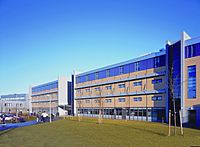
Starting in 1932, the Council built a huge housing project in Granton. Over 1,700 homes, mostly flats, were built. Most of these homes are still used today.
Much of the housing in West Granton was taken down starting in 1995.
The Edinburgh Waterfront project is a big plan to redevelop both Leith and Granton. The old gasworks site, which is huge, is being turned into the ForthQuarter. This will be a mix of homes, offices, shops, a park, and a new campus for Edinburgh College. As part of this redevelopment, a large storage building for the National Museums of Scotland opened in Granton in 1996.
In 2024, the last remaining gas holder was fixed up to be the main feature of the Waterfront redevelopment. The inside of the gas holder has been named the Granton Gas Holder Park. It will have a play area, space for art, a "relaxation area," exercise trails, and even space for markets and sports events. The whole structure will be lit up at night!
Who Lives in Granton?
Here's a quick look at the different groups of people living in Granton (in the Forth Ward) compared to all of Edinburgh:
| Ethnicity | Granton (Forth Ward) | Edinburgh |
|---|---|---|
| White | 84.6% | 84.9% |
| Asian | 7.1% | 8.6% |
| Black | 3.6% | 2.1% |
| Mixed | 2.0% | 2.5% |
| Other | 2.7% | 1.9% |
Famous People from Granton
- Henry Bellyse Baildon FRSE (1849–1907) – a poet and writer.
- John Roxburgh – a footballer.
- The Exploited – a punk rock band.


